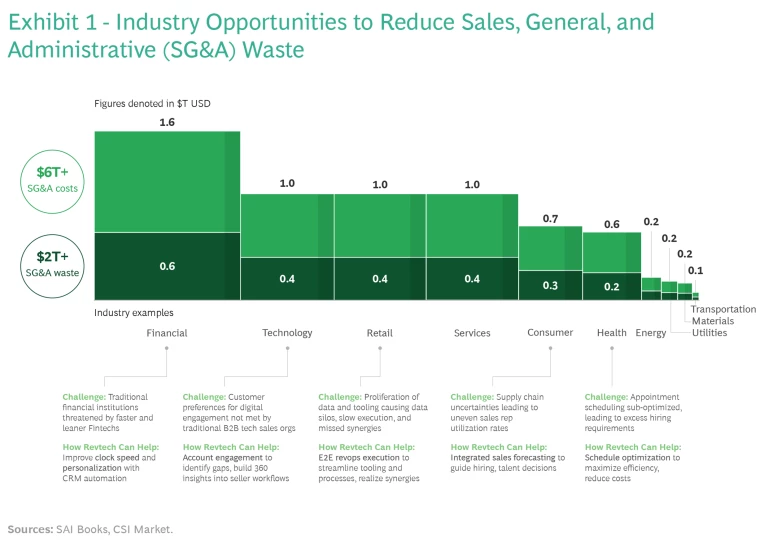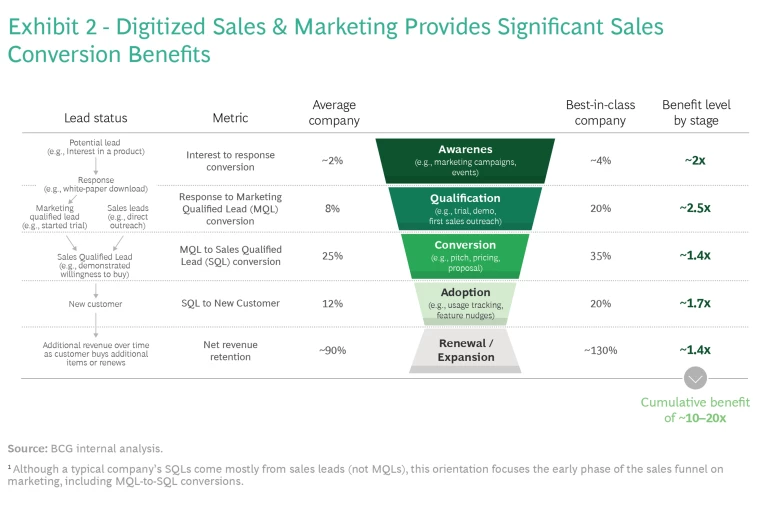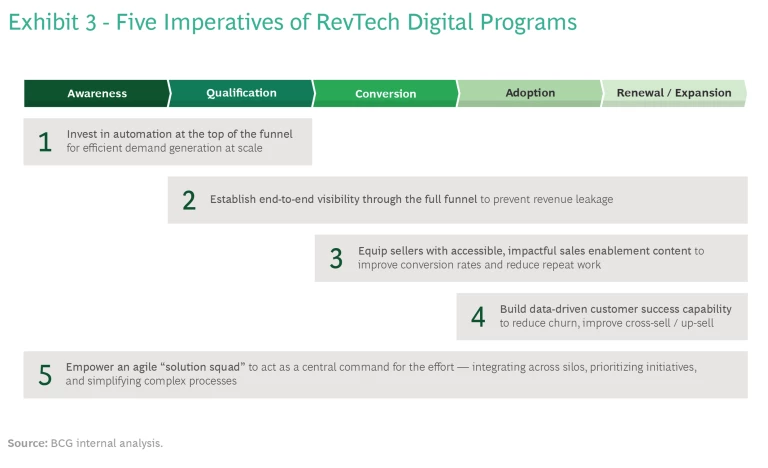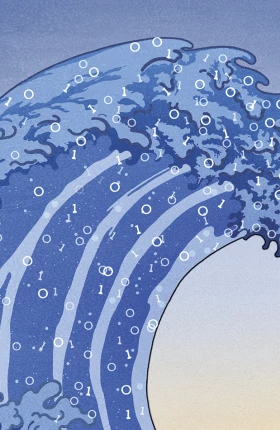Sales and marketing efforts could be wasting $2 trillion by focusing solely on driving higher revenues. A better option targets growth and efficiency with a new slate of technology-based tools.
Productivity shortfalls. Lost opportunities. Inefficient sales prospecting. Revenue leakage. Call it what you will, it all amounts to the same thing: companies in every major industry are leaving significant money on the table because of weaknesses in their go-to-market execution. Indeed, by BCG’s reckoning, today’s typical sales and marketing efforts could be wasting a whopping $2 trillion in excess sales, general, and administrative (SG&A) costs and lost revenue potential.
The problem for many companies is that they have invested heavily in CRM tools primarily to drive revenue growth. Viewed from one perspective, this plan has worked. CRM applications are expected to create $1.6 trillion in new business revenues worldwide by 2026. Yet at the same time, the costs of selling are rising rapidly. And in the current environment, in which optimizing every dollar invested in sales and marketing is more important than ever, many companies are stumped about how to stem these increasing expenditures—which are already beginning to outpace the revenue gains delivered by CRM. For these companies, the solution can be found in a refreshed go-to-market strategy that focuses on growth and efficiency—and that uses a new slate of sales and marketing tools we call RevTech.
RevTech Begins at the Top of the Sales Funnel
Building on what CRM has to offer, RevTech uses next-generation methods to automate sales processes. Examples include applying artificial intelligence (AI) to demand generation; providing full visibility and access to customer activities across the sales funnel (the channel through which customers travel from “I’m interested” to “I’ll buy it”); and equipping salespeople with the most impactful and relevant content for each customer to close the purchase. In other words, RevTech fully digitizes the top of the funnel, where the first opportunities from inbound marketing lie. It simplifies and streamlines sales processes and conversions, while targeting improvements in the bottom line.
The ways in which RevTech can make a difference—ultimately, a $2 trillion difference—vary by industry (see Exhibit 1). Consider the financial services sector, where at least the perception of one-on-one relationships with customers is crucial, and legacy companies have to contend with FinTechs poaching clients with digital conveniences. RevTech tools can help personalize, speed up, and smooth out customer interactions. And in the consumer products world, RevTech digital programs increase supply chain transparency so that sales forecasting, product availability, and inventories are aligned. In turn, decisions about sales campaigns and the type of talent needed to drive these efforts can be made with more information and greater confidence.
Most companies have yet to get the most out of RevTech, in large part because their implementation and use of the technologies have been focused on growth rather than efficiency. Indeed, although we estimate that most major companies waste roughly 30% to 50% of their sales budgets on inefficient processes, addressing this shortcoming by shifting to digital tools is often perceived as an overly difficult or cumbersome undertaking.
RevTech builds on CRM, using next-generation methods to simplify and streamline sales processes and conversions while improving the bottom line.
Some of this hesitance is cultural. Many companies have a deeply ingrained, “face-to-face first” mindset when it comes to sales. Sellers take pride in knowing their customers and are reluctant to use digital tools to initially find and engage leads or increase revenue from existing customers. In addition, from an implementation standpoint, data silos in company functions—like sales and marketing—are seen as too entrenched and proprietary to easily tear down in order to enable digital collaboration across the organization.
However, even with the limited uptake for RevTech, we have seen companies that implement digitized sales and marketing processes outperform their peers in every significant sales conversion category (see Exhibit 2). For instance, they are able to turn a prospect that is just kicking the tires into a genuine lead about two times more often than companies that have not yet adopted RevTech tools. They are also far better at drawing continuous revenue from customers through, for example, upselling or product and service renewals.
Optimizing Automation, Visibility, and Data
RevTech is an updated approach to sales and marketing—a holistic digital program that combines software with AI and machine learning, the rich use of data, and access to real-time content and analytics. RevTech strategies are comprised of five components (see Exhibit 3):
- Investing in automation to scale efficient demand generation
- Establishing end-to-end visibility through the full sales funnel
- Equipping sellers with relevant and accessible sales content to improve conversion rates
- Building data-driven customer success capabilities to reduce churn and increase cross-sell and up-sell rates
- Empowering an agile “solution squad” to act as a central nervous system for the effort, integrating across silos
Investing in automation to scale efficient demand generation
Although account-based marketing (ABM) is a mainstay of most sales efforts today, it is not being used to its greatest advantage. Typically, with ABM, marketers and sales teams map out semi-personalized sales strategies for individual customers, using analytics to explore past purchasing behavior and forecast possible future propensity. Because this is an expensive and labor-intensive process that requires dedicated marketers for each account, ABM has generally been limited to a small set of “main” customers. As a result, a lot of activity at the top of the sales funnel is ignored—and many potential leads fail to progress toward a sale.
With RevTech, using AI programs such as 6sense, Demandbase, and Terminus to automate sales strategies and analytics for customers makes it possible to operate ABM at scale. A cybersecurity firm’s recent implementation of an account engagement platform by 6sense offers a good example. The platform leveraged AI algorithms to dynamically identify and then rank sales leads based on the latest shifts in cyber threats and how these threats potentially impact current or prospective customers. The security firm used the AI reports to personalize individual sales campaigns for each potential customer, prioritize leads, and categorize them by their stage in the buying journey: Decision and Purchase? Or just Awareness and Consideration? Impressively, the firm was able to scale ABM across the sales channel with a 1.5-person marketing staff. Using this program, the pipeline-to-sales conversion rate jumped by 500% and deal sizes increased by 25%.
Establishing end-to-end visibility through the full sales funnel
Obviously, you can’t fix something if you can’t see what the problem is. In the sales world, that shortcoming generates revenue leakage. When visibility is lacking across the full customer journey, companies are ill-equipped to perform basic sales activities—like reaching out on time for a renewal or making recommendations about new products that existing customers may be interested in. Conversion rates fall, churn rates rise, and cross-sell and up-sell opportunities suffer.
Moreover, companies without pipeline transparency are unable to fully examine the performance of each element of a sales campaign—especially across geographic regions, customer demographics, and product types. They lack sufficient data to conduct root cause analysis and to establish and syndicate best practices.
RevTech programs connect internal and external data sources, sales platforms, and account records to see through the sales funnel and reduce leakage.
To see through the full sales funnel and reduce leakage, RevTech programs—Clari, Outreach, and Gong, for example—that connect dozens of internal and external data sources, sales platforms, and account records are essential.
We saw this in action at a large B2B Software-as-a-Service (SaaS) firm with about 500,000 customers and 2,500 sellers. The firm used the revenue operations platform Clari to automate data capture so sales reps can focus on selling rather than data entry. Clari continuously analyzes historical and current data to predict sales outcomes based on product, region, purchasing activity, and other critical variables. Besides serving as a sales tool, the platform is also used for business forecasting, for real-time monitoring of sales pipeline changes that can be early warning signs of a market shift, and for driving sales training sessions.
Using these RevTech visibility tools to address revenue leak, the firm’s sales forecasting accuracy increased to 97% and revenue grew by 30%.
Equipping sellers with relevant and accessible sales content to improve conversion rates
One obvious driver of outsized sales costs is low conversion rates—or too many resources spent on trying to close sales that ultimately go elsewhere. Looking at it from the customer’s perspective, two factors stand out for choosing not to make a purchase. First, the seller lacks industry-specific expertise related to how the product can be customized or best utilized in the customer’s sector or pertaining to the most popular and unique ways that consumers put it to use. Second, the seller is too slow, not providing relevant information or responding to customer questions quickly enough, leaving the door open for a competitor to come in with a better bid or an alternative product.
These two factors are often related. Rather than closing the deal, sellers are spending time conducting research, consulting experts, and creating content—and reinventing the wheel over and over again for each customer. To make matters worse, many large organizations have ready-made content to personalize a sale, but they lack internal search functionality or support processes to make this content instantly accessible to salespeople in an appropriately targeted fashion. This can be achieved leveraging tools such as Highspot and Seismic.
We have witnessed poor content management at companies large and small, including at one firm whose main products ironically help companies manage unwieldy paperwork, including employee travel and entertainment expenses and invoices. At this company, sales content used to respond to prospective customers with relevant information was scattered over multiple databases housed in multiple repositories. Worse yet, the content could not be accessed easily because each database had distinctive search rules and content tags.
Some salespeople were falling back on out-of-date content, and others were creating their own “original” assets—resulting in inconsistent messaging and ineffective sales conversations. This also meant that content effectiveness could not be measured, making it impossible to improve or hone messaging.
To mitigate these problems, the company consolidated the databases into a single sales enablement and content management system using Highspot. The platform allows full semantic search, content scoring by relevance and frequency of access, and content targeting that recommends the best material for specific customers based on their profile, history, and sales stage. Among other benefits, machine learning capabilities that automate scoring and targeting eliminate the need for time-consuming manual tagging of content.
Now fully rolled out, the platform is extremely popular at the company and has been adopted by upwards of 95% of sales reps. In the process, the company estimates that it has increased productivity by around 10%.
Building data-driven customer success capabilities to reduce churn and increase cross-sell and up-sell rates
One of the most significant by-products of subscription-based software business models is the increased importance of “customer lifetime value” (CLTV) in driving revenue growth and sales efficiency. In some industries CLTV—which includes renewals as well as up-selling and cross-selling of other products—can be greater than the value of the initial sale by a factor of 25. Organizations know their existing customers’ needs and behaviors and can therefore target products and solutions to them effectively. And as sales shift online, businesses learn more about their customers, amassing even larger data sets of usage patterns, product feedback, and sales interactions.
Still, many companies miss a huge opportunity because they fail to capture and integrate this information into their databases. Or they don’t trust models that can be built from it—such as “next best offer” models that suggest to sales reps which products a customer may be subsequently interested in.
To effectively parse and make intelligent use of scattered, unrelated customer data and generate observations that can reduce churn and lead to revenue gains, companies are turning to tools like Gainsight, Service Hub, and ChurnZero. These platforms aggregate disparate sources of interaction data into a single, easily accessible data pool with embedded or customizable AI-driven recommendations and insights.
Businesses have large data sets of usage patterns, product feedback, and sales interactions, yet they fail to effectively capture and integrate this information.
The cloud-computing company Citrix illustrates how this can work. When Citrix transitioned from primarily an “on premise” business to a SaaS subscription model, it created a customer retention team. This small group of customer success managers (CSMs) realized some positive results early on, but was hamstrung by manual processes and the inability to scale their techniques and findings as more customers moved to subscription pricing. To mitigate this, Citrix used Gainsight to integrate and continually update key customer data sources—such as Salesforce CRM, Salesforce Service Cloud, and back-end databases containing vital customer information. This provided CSMs with impactful customer intelligence and timely subscription renewal reminders. With this change in approach, the Citrix net revenue retention rate increased by 15%.
Empowering an agile “solution squad” to act as a central nervous system for the effort, integrating across silos
If the rewards of investing in automation, establishing end-to-end visibility, equipping sellers with accessible content, and building a customer success function are high, so are the challenges. Trusting and leveraging technology to perform tasks critical for customer acquisition, conversion, and expansion is hard. Even companies that set out with the best intentions to digitize their go-to-market processes struggle. Indeed, only 30% of all digital transformations succeed.
To successfully deploy a winning RevTech strategy, companies need to establish a strategic, cross-functional central team with a clear, top-down leadership mandate to implement major changes. The team should have the following responsibilities:
- Setting and coordinating RevTech strategy and activities so that they are connected to revenue targets
- Identifying and prioritizing use cases (e.g., ABM at scale) to ensure that RevTech activities are directly linked to a clear business case and an anticipated return on investment
- Building an integrated data platform that serves as a single source of information containing all sales data used throughout the organization
- Selecting appropriate tool vendors based on specific and prioritized use cases
- Connecting tools so that they work together, creating compounded efficiency across the sales effort and reducing wasted sales expenses
- Developing a workforce that trusts the RevTech tools by implementing pilot programs to help people feel comfortable with the technology
- Identifying RevTech champions to phase in its use across the organization
- Establishing a management system to measure the success of the program and steer its direction based on quarterly objectives and regularly updated results
For most companies, sales and marketing are the lifeblood of the business. It is where R&D, design, and production innovation meet the customer. The performance of sales and marketing functions can be the difference between forging a long and prosperous relationship or losing a customer to a competitor.
But delivering an excellent customer experience in sales and marketing does not have to come at a high cost. RevTech can help companies drive both top-line growth and bottom-line efficiencies by automating and scaling demand generation, providing visibility across the full sales funnel, and streamlining and increasing the value of sales content management. Combined, these capabilities amount to $2 trillion in reduced costs and increased sales that companies can ill afford to neglect anymore.









